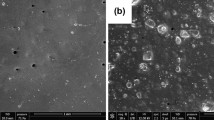Abstract
White pigments are used in most paints, plastics, and paper laminates because of their ability to not only lighten color, but also to provide full opacity. Although many particles are white in air, the opacifying ability of TiO2 is so much greater than the others that it is nearly always the white pigment used in these applications. The light scattering strength of TiO2 is very sensitive to a number of particle parameters, most importantly particle size and degree of dispersion, and so pigment producers must manufacture these particles to tight specifications. Once the particles are made, their surfaces must be modified to ensure optimal opacity performance as well as to improve other properties of the end-use material (for example, durability). This is typically done by depositing hydrous silica, hydrous alumina, an organic material, or some combination of the three onto the pigment surface. In this chapter, we discuss the processes of making the TiO2 particles and modifying their surfaces, as well as the effects that these modifications have on a number of important end-use properties. While TiO2 is the predominant white pigment, in certain applications, other materials, such as lithopone, zinc sulfide, and zinc oxide, are used. These applications fall into two classes—those that avoid TiO2 for cost reasons and those that avoid TiO2 because this material negatively affects a critical property of the intended application.
Access this chapter
Tax calculation will be finalised at checkout
Purchases are for personal use only
Similar content being viewed by others
Notes
- 1.
Except by a small reduction due to the slight dilution of the TiO2 by the surface modifier(s).
- 2.
This refers to expense on a coverage basis—that is, based on the cost to make a unit area of paint film or plastic opaque—rather than on a weight basis.
References
Schonbrun, Z.: The quest for the next billion-dollar color. Bloomberg Businessweek (2018)
Veronovski, N.: Titanium dioxide—material for a sustainable environment. IntechOpen 421, (2018)
Iler, R.K.: Product comprising a skin of dense, hydrated amorphous silica bound upon a core of another solid material and a process of making same. US 2,885,366 (1969)
Iler, R.K.: The chemistry of silica: solubility, polymerization, colloid and surface properties and biochemistry of silica. Wiley-Interscience (1979)
Werner, A.J.: Titanium dioxide pigment coated with silica and alumina. US Re. 27,818 (1973)
Diebold, M.P., Bettler, C.R.: Easy to disperse, high durability tio2 pigment and method for making same. US 6,783,586 (2004)
Diebold, M.P., Bettler, C.R.: Easy to disperse, high durability tio2 pigment and method for making same. US 8,105,432 (2012)
Diebold, M.P., Kraiter, D.K., Rusnak, E., Shih, A.: Treated inorganic pigments having improved dispersibility and use thereof in coating compositions. US 9,539,557 (2017)
Craig, D.H., Elliott, J.D., Ray, H.E.: Process for manufacturing zirconia-treated titanium dioxide pigments. US 7,238,231 (2007)
Diebold, M.P., Baidins, A.: High gloss durable TiO2 pigment. US 5,554,216 (1994)
Juergens, V., Siekman, J., Blumel, A.B., Schmitt, V.: Method for surface treatment of a titanium dioxide pigment. US 8,641,870 (2014)
Wachi, H., Egami, Y., Maekawa, H.: Surface coated particles and use of same. WO2014104225 (2014)
Drews-Nicolai, L., Bluemel, S.: Method for the post-treatment of titanium dioxide pigments. US 2006/0034739 (2006)
Jernakoff, P., Bolt, J.D.: Preparation of lacing resistant, titanium dioxide particles for use in photodurable thin film production. US 2020/0332074 (2020)
Jacobson, H.W.: TiO2 pigment bearing a coatings with fluoride ions and laminate and coatings based thereon. US 4,460,665 (1984)
Tooley, P.A., Niedenzu, P.M., Reid, A.H.Jr.: Organosilicon treatment of TiO2 pigment bearing a coating with fluoride ions. US 5,562,990 (1996)
Tooley, P.A., Holtzen, D.A., Musiano, J.A.: Processibility and lacing resistance when silanized pigments are incorporated in polymers. US 5,959,004 (1999)
Kinniard, S.P., Campeotto, A.: Improved method for manufacturing high opacity, durable pigment. EP 1 373 413 (2002)
Birmingham, J.N. et al.: Preparation of organic additive-treated, pyrogenic silica-encapsulated titanium dioxide particles. US 7,795,330 (2010)
Braun, J.H., Baidins, A., Marganski, R.E.: TiO2 pigment technology: a review. Prog. Organic. Coat. 20, 105 (1992)
Stieg, F.B.: Opaque white pigments in coatings. In: Tess, R.W., Poehlein, G.W. (eds.) Applied Polymer Science (Am. Chem. Soc.), vol. 285 (1985)
Pfaff, G.: Zinc sulfide pigments. Phys. Sci. Rev. 6(8), 369 (2021)
Jin, F.-L., Zhao, M., Park, M., Park, S.-J.: Recent trends of foaming in polymer processing: a review. Polymers 11(6), 953 (2019)
Breil, J.: Biaxially oriented films for packaging applications. In: Ebnesajjad, S. (ed.) Plastic Films in Food Packaging. William Andrew Publishing (2013)
Brunner, M., Tinkl, M., Brookes, D., Schulz, K.: Calcium carbonate as cavitation and voiding agents in biaxially oriented films. POLYMERS Communiqué 87 (2017)
McDonald, C.J., Devon, M.J.: Hollow latex particles: synthesis and applications. Adv. Colloid. Inter. Sci. 99, 181 (2002)
Hungenberg, K.-D., Jahns, E.: Trends in emulsion polymerization processes from an industrial perspective. In: Polymer Reaction Engineering of Dispersed Systems. Springer (2017)
Jiang, S., Van Dyk, A., Maurice, A., Bohling, J., Fasano, D., Brownelf, S.: Design colloidal particle morphology and self-assembly for coatings applications. Chem. Soc. Rev. 46(12), 3792 (2017)
Silva, J.F.A., et al.: Use of multi-hollow polyester particles as opacifying agent for injection-molded polyethylene. Polymers 12(6), 1331 (2020)
Braun, J.H., Dickinson, J.G.: White pigments. In: Craver, C., Carraher, C. (eds.) Applied Polymer Science: 21st Century. Elsevier (2000)
Author information
Authors and Affiliations
Rights and permissions
Copyright information
© 2022 The Author(s), under exclusive license to Springer Nature Switzerland AG
About this chapter
Cite this chapter
Diebold, M., Backer, S.D., Niedenzu, P.M., Hester, B.R., Vanhecke, F.A.C. (2022). White Pigments. In: Pigments, Extenders, and Particles in Surface Coatings and Plastics. Springer, Cham. https://doi.org/10.1007/978-3-030-99083-1_7
Download citation
DOI: https://doi.org/10.1007/978-3-030-99083-1_7
Published:
Publisher Name: Springer, Cham
Print ISBN: 978-3-030-99082-4
Online ISBN: 978-3-030-99083-1
eBook Packages: Chemistry and Materials ScienceChemistry and Material Science (R0)




